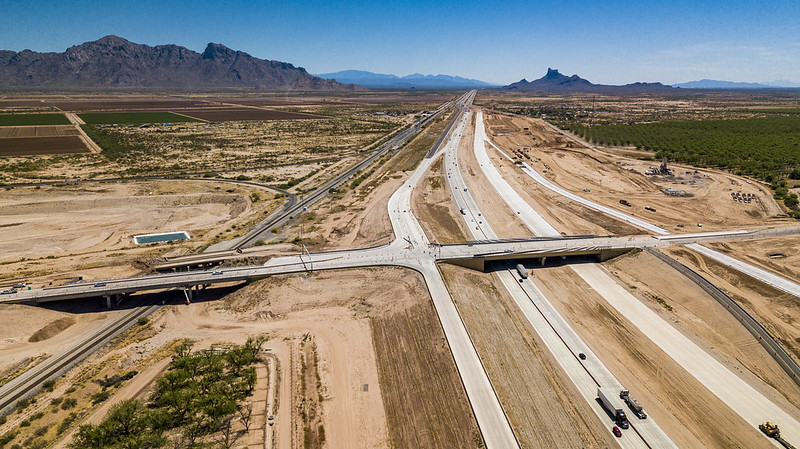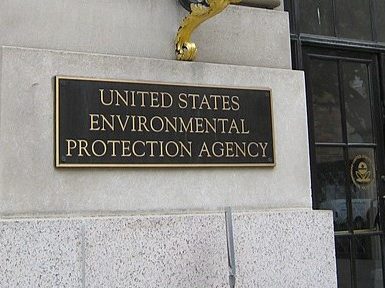Arizona Gov. Katie Hobbs and state leaders announced Monday that Arizona had secured a $95 million INFRA grant from the US Department of Transportation for major improvements to widen Interstate 10.
“The I-10 serves as a major connector for the entire state, and I am thrilled to announce that we have secured the funds necessary to ensure it remains a gateway for generations to come,” Hobbs said. “By securing this investment, we are not only improving our state’s infrastructure, we are propelling Arizona’s economy forward, ensuring a prosperous future for all. I want to thank (Gila River Indian Community) Governor Lewis for his tireless advocacy and our federal partners for helping make this possible.”
The purpose of the grant is to improve safety conditions on the highway, especially on the 26-mile stretch of the I-10 located within the Gila River Indian Community that sits between Chandler and Casa Grande. Some parts of the high-traffic stretch see up to 120,000 vehicles daily. This 26-mile segment of the I-10 is the last remaining unimproved section of the highway, with only two eastbound lanes and two westbound lanes.
Obtaining funding for this project has been a top priority for Hobbs, the Gila River Indian Community, the Arizona congressional delegation, and the Arizona state Legislature.
This grant represents a unique partnership of governments, involving state, federal, tribal, and county governments in the planning and development of the grant to address the safety and infrastructure needs in Arizona and within the Gila River Indian Community.
Funding was made possible by passage of the 2022 bipartisan infrastructure law, a bill that Sen. Kyrsten Sinema (I-AZ) played a significant role in shaping.
“I’m proud to secure these funds for I-10’s expansion through my bipartisan infrastructure law,” Sinema said. “I promised Arizonans I’d do the hard work to deliver real results, not lip service – today’s investment is one of many more to come for Arizona from my bipartisan infrastructure law.”
Over in the House. Rep. Juan Ciscomani (R-AZ) said he was pleased to land the funding despite years of delay.
“This grant funding will allow for the critical widening needed on one of the most dangerous stretches of highway in Arizona,” Ciscomani, who sits on the Appropriations Committee, said. “While it is overdue, I am pleased to see DOT recognize the importance of the project nationally and allocate the necessary resources.”
State Sen. T.J. Shope (R-Coolidge), a longtime advocate for the improvement project in his district, referred to the project on Monday while appearing on a panel about the positive economic effects of Lucid Motors’ investment in Casa Grande.
The unimproved area is especially dangerous because it creates bottlenecks and traffic delays. As Pinal County’s development as a manufacturing jobs hub continues to grow, freight mobility and commuter safety in the region has become a greater need.
On social media, Shope called the announcement, “the day we’ve been waiting for as the federal government saw fit to return some of our tax dollars to Arizona.”
Safety improvements along the corridor include:
- Adding a new general-purpose lane in the east- and westbound directions, extending the High Occupancy Vehicle (HOV) Lane on I-10 from Loop 202 to Riggs Road, and improving interchanges and crossroads will increase capacity and access. This improves safety by reducing congestion and travel times and lessening detoured traffic on the Gila River Indian Community.
- Replacing I-10 bridges over the Gila River will maintain a state of good repair by modernizing this key infrastructure.
- Building new and improved traffic interchanges creates safer crossings for farm equipment, bicyclists, and pedestrians and boosts connections and quality of life.
- Installing fiber optic infrastructure within ADOT Right-of-Way will allow for the installation of sensors, cameras, and other highway safety-related technology.
Key Commerce Corridor, Arizona Jobs, and Local Connections:
- As the principal roadway between metro Phoenix and Tucson for commuters, cross-country travelers, and commercial traffic, I-10 is a Key Commerce Corridor for Arizona and the U.S.
- The freeway provides a vital link for freight traffic from the ports of southern California and for international commerce, with a significant amount of freight transported along the route daily. The proposed improvements will boost the reliability of freight traffic in the corridor.
- The project, coupled with others around the state, will help attract employers and create jobs in Arizona.
- Locally, the route serves the Gila River Indian Community by improving connections to employment, medical, educational, and other critical services both within and outside of the Community.
Funding for improvements:
- The total estimated project cost is approximately $1 billion.
- $692 million allocated in the state budget
- $221 million in MAG funding
- $95 million in DOT INFRA grant funding
Timeline of the project:
- Following completion of the required environmental review and clearance, work is expected to start in 2024, beginning with expanding the bridges that carry traffic over the Gila River.
- The target completion date for the full project has not been determined. For more information on the I-10 Wild Horse Pass study: i10wildhorsepasscorridor.com.
- ADOT works in partnership with MAG on the planning and construction of new freeways, additional lanes, and other improvements in the Phoenix area as part of the Regional Transportation Plan.
Photo courtesy ADOT flickr.
















Add comment